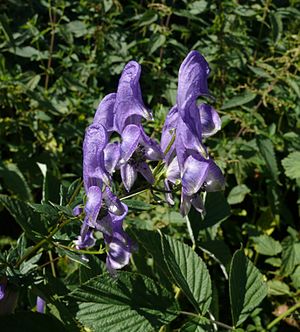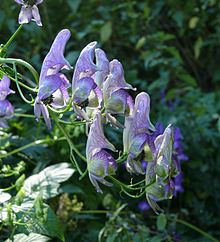Colorful monkshood
| Colorful monkshood | ||||||||||||
|---|---|---|---|---|---|---|---|---|---|---|---|---|

Colored monkshood ( Aconitum variegatum ) |
||||||||||||
| Systematics | ||||||||||||
|
||||||||||||
| Scientific name | ||||||||||||
| Aconitum variegatum | ||||||||||||
| L. |
The colorful monkshood ( Aconitum variegatum ), also called pied monkshood , is a species of the genus monkshood ( Aconitum ) within the buttercup family (Ranunculaceae). It is common in the mountainous areas of Europe.
Description and differentiation to similar species
Vegetative characteristics
The colorful monkshood grows as a deciduous, perennial herbaceous plant and usually reaches heights of 60 to 200 (25 to 250) centimeters. The upright or overhanging, to-and-fro stems are bare.
The alternate leaves are usually stalked and sitting in the upper stem area. The leaf blades are three to seven parts and, especially in the upper stem area, usually not divided down to the base. It is Netznervatur present.
Generative characteristics
The flowering time is at the end of early summer and extends from July to September. A racemose inflorescence is formed. The flower stalk is glabrous and glandless. The relatively large, hermaphrodite flowers are zygomorphic and five-fold. The bracts are bare outside. The purple, rarely blue flower helmets are hairy only on the back and are significantly higher than they are wide, in a ratio of 1: 2.5. The straight nectaries do not reach the summit of the helmet. The three to five mostly free fruit leaves are hairy on the belly seams. The seeds are brown.
The number of chromosomes is 2n = 16.
Ingredients and toxicity
The colorful monkshood contains talatisamine , an alkaloid that is similar to aconitine , in all parts of the plant . As a result, the plant should be as poisonous as the blue monkshood.
Similar species
From the similar Rispigen Eisenhut ( Aconitum paniculatum Lam. ), With which the colorful monkshood to the collective species Aconitum variegatum agg. is summarized, it differs by bald or at least not glandular hairy flower stalks and the higher helmet. The helmet of the colorful monkshood, which is characteristic of the genus, is about twice as high as it is wide and piebald, which distinguishes it from the blue monkshood .
ecology
The colorful monkshood is a hemicryptophyte .
A special feature of Aconitum variegatum is the flower bud, which is filled with a watery liquid during its development. In this miniature body of water ( phytotelm ) yeast live for a few days .
Occurrence and endangerment
The colorful monkshood is common in the mountainous areas of Europe. The colorful monkshood ( Aconitum variegatum subsp. Variegatum ) is rarely found in Central Europe in the Harz Mountains , in the Rhön , in the Swabian-Franconian Jura, in the Bavarian Forest, in the Alpine foothills and in the eastern chains of the Alps (east of a line from Lindau to Lake Maggiore ), but mostly in smaller stocks .
The colorful monkshood populates floodplain forests, scrub along the stream and tall herbaceous meadows, but more often it goes into dry, summer-warm bushes. It can be found especially on streams in alluvial forests , but also in beech forests and subalpine tall herbaceous meadows . It thrives in the company of the Alnetum incanae from the Alno-Ulmion association, but also in companies of the Tilio-Acerion, Berberidion and, more rarely, the Adensotylion associations. In the Allgäu Alps in Bavaria, it rises on the Falken above the Engeratsgundsee up to 2080 meters above sea level.
The colorful monkshood thrives best on soaky, also wet, nutrient-rich , mildly humus-rich loam and clay soils .
The pied monkshood was rated as safe in the Red List in Germany in 1996 , but has been specially protected in Germany since 1980 according to the BNatSchG (Law on Nature Conservation and Landscape Management, for short Federal Nature Conservation Act ).
Systematics and distribution of the subspecies
Aconitum variegatum was first published in 1753 by Carl von Linné .
A distinction is made between three subspecies of Aconitum variegatum in Europe in 1989 :
- Aconitum variegatum subsp. nasutum (Fisch. ex Rchb.) Götz (Syn .: Aconitum nasutum Rchb. , Aconitum paniculatum subsp. nasutum (Fisch.) Götz ): It occurs in southeastern Europe , in northeastern Anatolia and in the Caucasus , is absent in Germany.
- Aconitum variegatum subsp. pyrenaicum Vivant : It occurs only in the Pyrenees in Spain and France.
- Aconitum variegatum L. subsp. variegatum ( Aconitum cernuum auct. non Wulfen , Aconitum matthioli Rchb. ): It occurs in Central, Eastern and Northern Southern Europe . In the former Yugoslavia and Italy the nominate form is subsp. variegatum by the subsp. nasutum represented. In Germany, Aconitum variegatum subsp. variegatum especially in the Harz , in the Rhön , in the Thuringian Forest , in the Ore Mountains , in the Swabian and Franconian Alb , in the Bavarian Forest , in the Alpine foothills and in the Alps .
Common names
Only regional trivial names are: Eliaswagen ( Weser ), Gickel and Tise ( Silesia ), Narrenkap ( Prussia ), Peer un Wagen ( Bremen ) and Rüter to Peer (Bremen).
literature
- Erich Oberdorfer : Plant-sociological excursion flora . With the collaboration of Theo Müller. 5th, revised and expanded edition. Eugen Ulmer, Stuttgart (Hohenheim) 1983, ISBN 3-8001-3429-2 .
Individual evidence
- ↑ a b c d e f g h i Aconitum variegatum L., Bunter Eisenhut. In: FloraWeb.de.
- ↑ a b Erich Oberdorfer : Plant-sociological excursion flora for Germany and neighboring areas . With the collaboration of Angelika Schwabe and Theo Müller. 8th, heavily revised and expanded edition. Eugen Ulmer, Stuttgart (Hohenheim) 2001, ISBN 3-8001-3131-5 , pp. 400 .
- ↑ Hans Molisch : About the water cup of the flower buds of Aconitum variegatum. In: Reports of the German Botanical Society. Volume 38, pp. 341-346. Scanned at biodiversitylibrary.org .
- ↑ a b c Dietmar Aichele, Heinz-Werner Schwegler: The flowering plants of Central Europe. Volume 2: Yew plants to butterfly plants. 2nd Edition. Franckh-Kosmos, Stuttgart 2000, ISBN 3-440-08048-X .
- ↑ Erhard Dörr, Wolfgang Lippert : Flora of the Allgäu and its surroundings. Volume 1, IHW, Eching 2001, ISBN 3-930167-50-6 , p. 522.
- ↑ data sheet at WISA.
- ↑ Jaakko Jalas, Juha Suominen (ed.): Atlas Florae Europaeae. Distribution of Vascular Plants in Europe. Volume 8: Nymphaeaceae to Ranunculaceae. Akateeminen Kirjakauppa, The Committee for Mapping the Flora of Europe & Societas Biologica Fennica Vanamo, Helsinki 1989, ISBN 951-9108-07-6 , pp. 48-49.
- ↑ Carl Jessen : The German folk names of plants. Publisher by Philipp Cohen, Hannover 1882, p. 9.
Web links
- Distribution map for Germany. In: Floraweb .
- Colorful monkshood . In: BiolFlor, the database of biological-ecological characteristics of the flora of Germany.
- Profile and distribution map for Bavaria . In: Botanical Information Hub of Bavaria .
- Aconitum variegatum L. s. l. In: Info Flora , the national data and information center for Swiss flora . Retrieved October 18, 2015.
- Thomas Meyer: Data sheet with identification key and photos at Flora-de: Flora von Deutschland (old name of the website: Flowers in Swabia )
- giftpflanze.com .
- Data sheet with distribution in France at tela-botanica .
- Data sheet with photos and distribution in Italy at Flora Italiana by Schede di Botanica .
- Worldwide distribution.
- Günther Blaich: data sheet with photos.
- Gerhard Nitter: Profile with photos.


